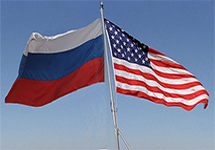William Potter
September 3, 2013

US Russia Flags, WikiMedia Commons
Objectively, more so than ever, U.S. and Russian interests converge on the most pressing global challenges, including weapons proliferation, terrorism, environmental degradation, pandemics, regional instability, failing and failed states. Absent active collaboration, it is impractical to fashion effective responses to these challenges. Although more cooperation is ongoing in a number of these areas than is widely appreciated, domestic political considerations are having an unfortunate chilling effect, which could lead both states to assume very counterproductive positions.
Perhaps the two greatest dangers are that (1) the Russian leadership will conclude there is little reason to engage with the United States as it cannot deliver on issues that are of importance to Russia, a perception undoubtedly reinforced by the cancellation of the summit and an interpretation of this as evidence of President Obama’s weakened political position; and (2) the temptation on the part of the United States to attempt to punish Russia for perceived transgressions. The most disconcerting aspect of the situation is that leading voices in government in both countries today appear to be essentially content with the status quo stalemate, albeit for different reasons, and are disinclined to invest the political capital needed to promote greater cooperation.
Convene an “Agenda-free” Summit
In charting a course forward, it is useful to recall that even during the bleakest moments of the Cold War, the United States and the Soviet Union were able to set aside their ideological and political differences to cooperate meaningfully and in a sustained fashion in a number of areas, most notably nuclear nonproliferation. It would be tragic—and very dangerous—were such cooperation to diminish in the post-Cold War period. As such, it is worth considering the value added of reviving the high-level biannual nonproliferation meetings that covered the entire range of proliferation concerns held by either party. More generally, it would be desirable to expand the number of bilateral and multilateral working groups at the Track 1, Track 1.5, and Track 2 levels that conduct business largely below the radar screen of politicians and the media. It also is highly desirable to facilitate more exchanges among different groups of students and professionals in both countries, including educators, military personnel, agricultural experts, etc., and to promote collaborative educational activities such as joint graduate degree programs.
To the extent that one sought to return to the summit process, it might make more sense to convene an “agenda-free” summit at which the U.S. and Russian leadership could discuss global affairs in a broad and largely unstructured way (perhaps the closest model is the December 1989 Bush-Gorbachev summit at Malta). Such a discussion of shared and divergent threat perceptions should lead to the recognition that on many, if not most, issues the two parties desire similar outcomes but differ mainly on the means to obtain them.
A major obstacle to improved relations that must be recognized if it is to be overcome is the persistence of very different perceptions the two countries have of one another. Both talk about the need for collaboration, but the U.S. tends to view Russia as a potential ally only when it is prepared to promote U.S. priorities, and typically is disparaging of Russian power, is insensitive to the legitimacy of Russian interests, and discounts the domestic support Putin enjoys for pursuing precisely those policies that are anathema to the United States. For its part, while Russia may see the U.S. as in decline, it is hypersensitive to its own vulnerabilities and takes umbrage at the various “slights” that it incurs, although these are invisible to most U.S. policymakers.
One possible way to minimize the negative influence of domestic politics on U.S.–Russian cooperation is to embed collaboration whenever possible in more multilateral fora. Examples where this already is ongoing, but could be expanded and intensified, are in areas such as nonproliferation and disarmament (P-5 consultations on disarmament are a good example, although they are not without a downside); counter-terrorism, nuclear security, nonproliferation education, environmental remediation, etc.
Very importantly, civil society must make the case loudly and clearly, that both sides need one another and acceptance of the status quo is unacceptable.
